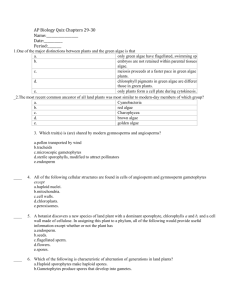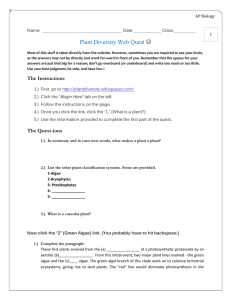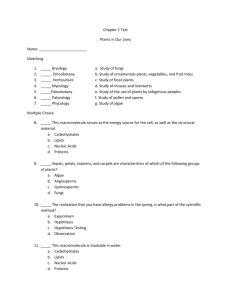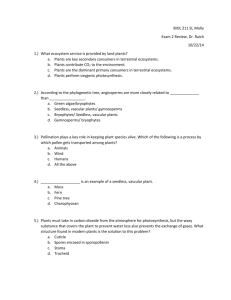3: Plant Kingdom
advertisement
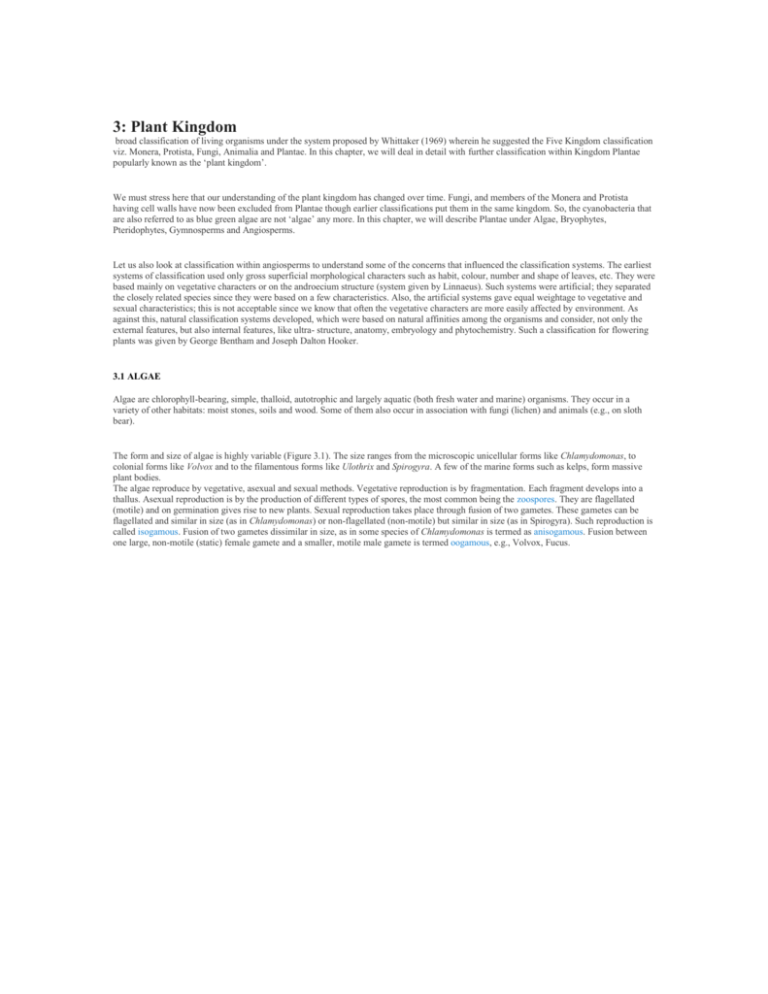
3: Plant Kingdom broad classification of living organisms under the system proposed by Whittaker (1969) wherein he suggested the Five Kingdom classification viz. Monera, Protista, Fungi, Animalia and Plantae. In this chapter, we will deal in detail with further classification within Kingdom Plantae popularly known as the ‘plant kingdom’. We must stress here that our understanding of the plant kingdom has changed over time. Fungi, and members of the Monera and Protista having cell walls have now been excluded from Plantae though earlier classifications put them in the same kingdom. So, the cyanobacteria that are also referred to as blue green algae are not ‘algae’ any more. In this chapter, we will describe Plantae under Algae, Bryophytes, Pteridophytes, Gymnosperms and Angiosperms. Let us also look at classification within angiosperms to understand some of the concerns that influenced the classification systems. The earliest systems of classification used only gross superficial morphological characters such as habit, colour, number and shape of leaves, etc. They were based mainly on vegetative characters or on the androecium structure (system given by Linnaeus). Such systems were artificial; they separated the closely related species since they were based on a few characteristics. Also, the artificial systems gave equal weightage to vegetative and sexual characteristics; this is not acceptable since we know that often the vegetative characters are more easily affected by environment. As against this, natural classification systems developed, which were based on natural affinities among the organisms and consider, not only the external features, but also internal features, like ultra- structure, anatomy, embryology and phytochemistry. Such a classification for flowering plants was given by George Bentham and Joseph Dalton Hooker. 3.1 ALGAE Algae are chlorophyll-bearing, simple, thalloid, autotrophic and largely aquatic (both fresh water and marine) organisms. They occur in a variety of other habitats: moist stones, soils and wood. Some of them also occur in association with fungi (lichen) and animals (e.g., on sloth bear). The form and size of algae is highly variable (Figure 3.1). The size ranges from the microscopic unicellular forms like Chlamydomonas, to colonial forms like Volvox and to the filamentous forms like Ulothrix and Spirogyra. A few of the marine forms such as kelps, form massive plant bodies. The algae reproduce by vegetative, asexual and sexual methods. Vegetative reproduction is by fragmentation. Each fragment develops into a thallus. Asexual reproduction is by the production of different types of spores, the most common being the zoospores. They are flagellated (motile) and on germination gives rise to new plants. Sexual reproduction takes place through fusion of two gametes. These gametes can be flagellated and similar in size (as in Chlamydomonas) or non-flagellated (non-motile) but similar in size (as in Spirogyra). Such reproduction is called isogamous. Fusion of two gametes dissimilar in size, as in some species of Chlamydomonas is termed as anisogamous. Fusion between one large, non-motile (static) female gamete and a smaller, motile male gamete is termed oogamous, e.g., Volvox, Fucus. Figure 3.1 Algae : (a) Green algae (i) Volvox (ii) Chlamydomonas (iii) Chara (b) Brown algae (i) Laminaria (ii) Fucus (iii) Dictyota (c) Red algae (i) Porphyra (ii) Polysiphonia Algae are useful to man in a variety of ways. At least a half of the total carbon dioxide fixation on earth is carried out by algae through photosynthesis. Being photosynthetic they increase the level of dissolved oxygen in their immediate environment. They are of paramount importance as primary producers of energy-rich compounds which form the basis of the food cycles of all aquatic animals. Many species of Porphyra, Laminaria and Sargassum are among the 70 species of marine algae used as food. Certain marine brown and red algae produce large amounts of hydrocolloids (water holding substances), e.g., algin (brown algae) and carrageen (red algae) are used commercially. Agar, one of the commercial products obtained from Gelidium and Gracilaria are used to grow microbes and in preparations of ice-creams and jellies. Chlorella and Spirullina are unicellular algae, rich in proteins and are used as food supplements even by space travellers. The algae are divided into three main classes: Chlorophyceae, Phaeophyceae and Rhodophyceae. 3.2 BRYOPHYTES Bryophytes include the various mosses and liverworts that are found commonly growing in moist shaded areas in the hills (Figure 3.2). Figure 3.2 Bryophytes: A liverwort – Marchantia (a) Female thallus (b) Male thallus Mosses – (c) Funaria, gametophyte and sporophyte (d) Sphagnum gametophyte Bryophytes are also called amphibians of the plant kingdom because these plants can live in soil but are dependent on water for sexual reproduction. They usually occur in damp, humid and shaded localities. They play an important role in plant succession on bare rocks/soil. The plant body of bryophytes is more differentiated than that of algae. It is thallus-like and prostrate or erect, and attached to the substratum by unicellular or multicellular rhizoids. They lack true roots, stem or leaves. They may possess root-like, leaf-like or stem-like structures. The main plant body of the bryophyte is haploid. It produces gametes, hence is called a gametophyte. The sex organs in bryophytes are multicellular. The male sex organ is called antheridium. They produce biflagellate antherozoids. The female sex organ called archegonium is flask-shaped and produces a single egg. The antherozoids are released into water where they come in contact with archegonium. An antherozoid fuses with the egg to produce the zygote. Zygotes do not undergo reduction division immediately. They produce a multicellular body called a sporophyte. The sporophyte is not free-living but attached to the photosynthetic gametophyte and derives nourishment from it. Some cells of the sporophyte undergo reduction division (meiosis) to produce haploid spores. These spores germinate to produce gametophyte. Bryophytes in general are of little economic importance but some mosses provide food for herbaceous mammals, birds and other animals. Species of Sphagnum, a moss, provide peat that have long been used as fuel, and because of their capacity to hold water as packing material for trans-shipment of living material. Mosses along with lichens are the first organisms to colonise rocks and hence, are of great ecological importance. They decompose rocks making the substrate suitable for the growth of higher plants. Since mosses form dense mats on the soil, they reduce the impact of falling rain and prevent soil erosion. The bryophytes are divided into liverworts and mosses. 3. 3.3 PTERIDOPHYTES The Pteridophytes include horsetails and ferns. Pteridophytes are used for medicinal purposes and as soil-binders. They are also frequently grown as ornamentals. Evolutionarily, they are the first terrestrial plants to possess vascular tissues – xylem and phloem. You shall study more about these tissues in Chapter 6. The pteridophytes are found in cool, damp, shady places though some may flourish well in sandy-soil conditions. You may recall that in bryophytes the dominant phase in the life cycle is the gametophytic plant body. However, in pteridophytes, the main plant body is a sporophyte which is differentiated into true root, stem and leaves (Figure 3.3). These organs possess well-differentiated vascular tissues. The leaves in pteridophyta are small (microphylls) as in Selaginella or large (macrophylls) as in ferns. The sporophytes bear sporangia that are subtended by leaf-like appendages called sporophylls. In some cases sporophylls may form distinct compact structures called strobili or cones (Selaginella, Equisetum). The sporangia produce spores by meiosis in spore mother cells. The spores germinate to give rise to inconspicuous, small but multicellular, free-living, mostly photosynthetic thalloid gametophytes called prothallus. These gametophytes require cool, damp, shady places to grow. Because of this specific restricted requirement and the need for water for fertilisation, the spread of living pteridophytes is limited and restricted to narrow geographical regions. The gametophytes bear male and female sex organs called antheridia and archegonia, respectively. Water is required for transfer of antherozoids – the male gametes released from the antheridia, to the mouth of archegonium. Fusion of male gamete with the egg present in the archegonium result in the formation of zygote. Zygote thereafter produces a multicellular well-differentiated sporophyte which is the dominant phase of the pteridophytes. In majority of the pteridophytes all the spores are of similar kinds; such plants are called homosporous. Genera like Selaginella and Salvinia which produce two kinds of spores, macro (large) and micro (small) spores, are known as heterosporous. The megaspores and microspores germinate and give rise to female and male gametophytes, respectively. The female gametophytes in these plants are retained on the parent sporophytes for variable periods. The development of the zygotes into young embryos take place within the female gametophytes. This event is a precursor to the seed habit considered an important step in evolution. The pteridophytes are further classified into four classes: Psilopsida (Psilotum); Lycopsida (Selaginella, Lycopodium), Sphenopsida (Equisetum) and Pteropsida (Dryopteris, Pteris, Adiantum). 3.4 GYMNOSPERMS The gymnosperms (gymnos : naked, sperma : seeds) are plants in which the ovules are not enclosed by any ovary wall and remain exposed, both before and after fertilisation. The seeds that develop post-fertilisation, are not covered, i.e., are naked. Gymnosperms include mediumsized trees or tall trees and shrubs (Figure 3.4). One of the gymnosperms, the giant redwood tree Sequoia is one of the tallest tree species. The roots are generally tap roots. Roots in some genera have fungal association in the form of mycorrhiza (Pinus), while in some others (Cycas) small specialised roots called coralloid roots are associated with N – fixing cyanobacteria. The stems are unbranched (Cycas) or branched (Pinus, Cedrus). The leaves may be simple or compound. In Cycas the pinnate leaves persist for a few years. The leaves in gymnosperms are well-adapted to withstand extremes of temperature, humidity and wind. In conifers, the needle-like leaves reduce the surface area. Their thick cuticle and sunken stomata also help to reduce water loss. The gymnosperms are heterosporous; they produce haploid microspores and megaspores. The two kinds of spores are produced within sporangia that are borne on sporophylls which are arranged spirally along an axis to form lax or compact strobili or cones. The strobili bearing microsporophylls and microsporangia are called microsporangiate or male strobili. The microspores develop into a male gametophytic generation which is highly reduced and is confined to only a limited number of cells. This reduced gametophyte is called a pollen grain. The development of pollen grains take place within the microsporangia. The cones bearing megasporophylls with ovules or megasporangia are called macrosporangiate or female strobili. The male or female cones or strobili may be borne on the same tree (Pinus). However, in cycas male cones and megasporophylls are borne on different trees. The megaspore mother cell is differentiated from one of the cells of the nucellus. The nucellus is protected by envelopes and the composite structure is called an ovule. The ovules are borne on megasporophylls which may be clustered to form the female cones. The megaspore mother cell divides meiotically to form four megaspores. One of the megaspores enclosed within the megasporangium (nucellus) develops into a multicellular female gametophyte that bears two or more archegonia or female sex organs. The multicellular female gametophyte is also retained within megasporangium. Unlike bryophytes and pteridophytes, in gymnosperms the male and the female gametophytes do not have an independent free-living existence. They remain within the sporangia retained on the sporophytes. The pollen grain is released from the microsporangium. They are carried in air currents and come in contact with the opening of the ovules borne on megasporophylls. The pollen tube carrying the male gametes grows towards archegonia in the ovules and discharge their contents near the mouth of the archegonia. Following fertilisation, zygote develops in to an embryo and the ovules into seeds. These seeds are not covered. 3.5 ANGIOSPERMS Unlike the gymnosperms where the ovules are naked, in the angiosperms or flowering plants, the pollen grains and ovules are developed in specialised structures called flowers. In angiosperms, the seeds are enclosed by fruits. The angiosperms are an exceptionally large group of plants occurring in wide range of habitats. They range in size from tiny, almost microscopic Wolfia to tall trees of Eucalyptus (over 100 metres). They provide us with food, fodder, fuel, medicines and several other commercially important products. They are divided into two classes : the dicotyledons and the monocotyledons (Figure 3.5). The dicotyledons are characterised by having two cotyledons in their seeds while the monocolyledons have only one. The male sex organs in a flower is the stamen. Each stamen consists of a slender filament with an anther at the tip. The anthers, following meiosis, produce pollen grains. The female sex organs in a flower is the pistil or the carpel. Pistil consists of an ovary enclosing one to many ovules. Within ovules are present highly reduced female gametophytes termed embryo- sacs. The embryo-sac formation is preceded by meiosis. Hence, each of the cells of an embryo-sac is haploid. Each embryo-sac has a three-celled egg apparatus – one egg cell and two synergids, three antipodal cells and two polar nuclei. The polar nuclei eventually fuse to produce a diploid secondary nucleus. Pollen grain, after dispersal from the anthers, are carried by wind or various other agencies to the stigma of a pistil. This is termed as pollination. The pollen grains germinate on the stigma and the resulting pollen tubes grow through the tissues of stigma and style and reach the ovule. The pollen tubes enter the embryo-sac where two male gametes are discharged. One of the male gametes fuses with the egg cell to form a zygote (syngamy). The other male gamete fuses with the diploid secondary nucleus to produce the triploid primary endosperm nucleus (PEN). Because of the involvement of two fusions, this event is termed as double fertilisation, an event unique to angiosperms. The zygote develops into an embryo (with one or two cotyledons) and the PEN develops into endosperm which provides nourishment to the developing embryo. The synergids and antipodals degenerate after fertilisation. During these events the ovules develop into seeds and the ovaries develop into fruit. The life cycle of an angiosperm is shown in Figure 3.6. Figure 3.5 Angiosperms : (a) A dicotyledon (b) A monocotyledon Figure 3.6 Life cycle of an angiosperm Figure 3.7 Life cycle patterns : (a) Haplontic (b) Diplontic (c) Haplo-diplontic SUMMARY Plant kingdom includes algae, bryophytes, pteridophytes, gymnosperms and angiosperms. Algae are chlorophyll-bearing simple, thalloid, autotrophic and largely aquatic organisms. Depending on the type of pigment possesed and the type of stored food, algae are classfied into three classes, namely Chlorophyceae, Phaeophyceae and Rhodophyceae. Algae usually reproduce vegetatively by fragmentation, asexually by formation of different types of spores and sexually by formation of gametes which may show isogamy, anisogamy or oogamy. Bryophytes are plants which can live in soil but are dependent on water for sexual reproduction. Their plant body is more differentiated than that of algae. It is thallus-like and prostrate or erect and attached to the substratum by rhizoids. They possess root-like, leaf-like and stem-like structures. The bryophytes are divided into liverworts and mosses. The plant body of liverworts is thalloid and dorsiventral whereas mosses have upright, slender axes bearing spirally arranged leaves. The main plant body of a bryophyte is gamete-producing and is called a gametophyte. It bears the male sex organs called antheridia and female sex organs called archegonia. The male and female gametes produced fuse to form zygote which produces a multicellular body called a sporophyte. It produces haploid spores. The spores germinate to form gametophytes. In pteridophytes the main plant is a sporophyte which is differentiated into true root, stem and leaves. These organs possess well-differentiated vascular tissues. The sporophytes bear sporangia which produce spores. The spores germinate to form gametophytes which require cool, damp places to grow. The gametophytes bear male and female sex organs called antheridia and archegonia, respectively. Water is required for transfer of male gametes to archegonium where zygote is formed after fertilisation. The zygote produces a sporophyte. The gymnosperms are the plants in which ovules are not enclosed by any ovary wall. After fertilisation the seeds remain exposed and therefore these plants are called naked-seeded plants. The gymnosperms produce microspores and megaspores which are produced in microsporangia and megasporangia borne on the sporophylls. The sporophylls – microsporophylls and megasporophylls – are arranged spirally on axis to form male and female cones, respectively. The pollen grain germinates and pollen tube releases the male gamete into the ovule, where it fuses with the egg cell in archegonia. Following fertilisation, the zygote develops into embryo and the ovules into seeds. In angiosperms, the male sex organs (stamen) and female sex organs (pistil) are borne in a flower. Each stamen consists of a filament and an anther. The anther produces pollen grains (male gametophyte) after meiosis. The pistil consists of an ovary enclosing one to many ovules. Within the ovule is the female gametophyte or embryo sac which contains the egg cell. The pollen tube enters the embryo-sac where two male gametes are discharged. One male gamete fuses with egg cell (syngamy) and other fuses with diploid secondary nucleus (triple fusion). This phenomenon of two fusions is called double fertilisation and is unique to angiosperms. The angiosperms are divided into two classes – the dicotyledons and the monocotyledons. During the life cycle of any sexually reproducing plant, there is alternation of generations between gamete producing haploid gametophyte and spore producing diploid sporophyte. However, different plant groups as well as individuals may show different patterns of life cycles – haplontic, diplontic or intermediate.


